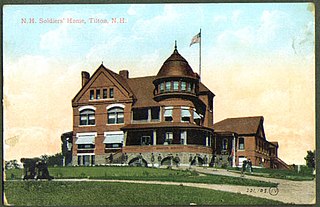
An old soldiers' home is a military veterans' retirement home, nursing home, or hospital, or sometimes an institution for the care of the widows and orphans of a nation's soldiers, sailors, and marines, etc.
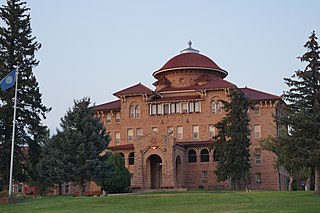
The National Asylum for Disabled Volunteer Soldiers was established on March 3, 1865, in the United States by Congress to provide care for volunteer soldiers who had been disabled through loss of limb, wounds, disease, or injury during service in the Union forces in the American Civil War. Initially, the Asylum, later called the Home, was planned to have three branches: in the Northeast, in the central area north of the Ohio River, and in what was then considered the Northwest, the present upper Midwest.
The Kennebec Central Railroad was a 2 ft narrow gauge railroad operating between Randolph and Togus, Maine. The railroad was built to offer transportation for American Civil War veterans living at Togus to the nearby City of Gardiner. Tracks of 25-pound steel rails ran five miles from Randolph, Maine to the veterans home at Togus. Train service began on 23 July 1890.

Camp Chase was a military staging and training camp established in Columbus, Ohio in May 1861 after the start of the American Civil War. It also included a large Union-operated prison camp for Confederate prisoners during the American Civil War.
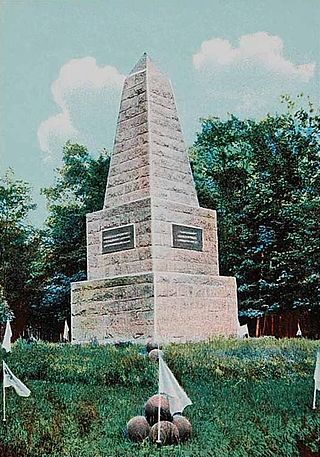
Togus National Cemetery is a United States National Cemetery located at Togus, Kennebec County, Maine. Administered by the United States Department of Veterans Affairs, it encompasses 31.2 acres (12.6 ha), and as of the end of 2020, had more than 5,300 interments. It is closed to new interments.

The Armed Forces Retirement Home refers to one of two Old Soldiers' retirement homes, one in Gulfport, Mississippi, the other in Washington, D.C., that house veterans and active duty members of the United States Armed Forces.

The Disabled American Veterans (DAV) is an organization created in 1920 by World War I veterans for disabled military veterans of the United States Armed Forces that helps them and their families through various means. It was issued a federal charter by Congress in 1932. It currently has over 1 million members. As a 501(c)(4) social welfare organization, it is outside the purview of – and therefore not rated by – Charity Navigator. DAV's Employer Identification Number (EIN) is 31–0263158.

Fort Whipple is a former United States (U.S.) Army post that was temporarily established at Del Rio Springs, north of present-day Chino Valley, Arizona, and later relocated to a permanent site near present-day Prescott, Arizona.

Fort Custer Training Center, often known simply as Fort Custer, is a federally owned and state-operated Michigan Army National Guard training facility, but is also used by other branches of the armed forces and armed forces from Illinois, Indiana, and Ohio. It is one of the most heavily used Midwest training facilities and is used mainly for company level small arms and maintenance training.

The Director's Quarters, Togus Veterans' Administration Center, previously known as the Governor's House, is a historic house on the grounds of the Veterans Administration (VA) facility in Togus, Maine. The house, built in 1869, is historically significant as the only surviving structure of the first National Home for Disabled Volunteer Soldiers, established at Togus in 1866 to serve American Civil War veterans. It was designated a National Historic Landmark in 1974. It is a contributing element of the historic district encompassing the Togus VA campus.

Kennebec Arsenal is a historic arsenal on Arsenal Street in Augusta, Maine. Largely developed between 1828 and 1838 in part because of border disputes with neighboring New Brunswick, it was designated a National Historic Landmark District in 2000 as a good example of a nearly intact early 19th-century munitions storage facility. The arsenal property was garrisoned until 1901, after which it was turned over to the State of Maine as an expansion of the adjacent Maine State Hospital. The state for many years housed mental health patients there.

The Sawtelle Veterans Home was a care home for disabled American veterans in what is today part of the Los Angeles metropolitan area in California in the United States. The Home, formally the Pacific Branch of the National Home for Disabled Volunteer Soldiers, was established in 1887 on 300 acres (1.2 km2) of Rancho San Vicente y Santa Monica lands donated by Senator John P. Jones and Arcadia B. de Baker. The following year, the site grew by an additional 200 acres (0.81 km2); in 1890, 20 acres (0.081 km2) more were appended for use as a veterans' cemetery. With more than 1,000 veterans in residence, a new hospital was erected in 1900. This hospital was replaced in 1927 by the James W. Wadsworth Hospital, now known as the West Los Angeles VA Medical Center.

The National Home for Disabled Volunteer Soldiers, Marion Branch is a historic old soldiers' home located in Marion, Indiana. The hospital, along with Marion National Cemetery were listed on the National Register of Historic Places in 1999 as a national historic district.
The 29th Maine Infantry Regiment was an infantry regiment that served in the Union Army during the American Civil War.

Harry S. Coombs (1878–1939) was an American architect practicing in Lewiston, Maine. He was the son of and successor to architect George M. Coombs.

The Northwestern Branch, National Home for Disabled Volunteer Soldiers Historic District is a veterans' hospital located in Milwaukee, Wisconsin, with roots going back to the Civil War. Contributing buildings in the district were constructed from 1867 to 1955, and the 90 acres (36 ha) historic district of the Milwaukee Soldiers Home campus lies within the 400 acres (160 ha) Clement J. Zablocki VA Medical Center grounds, just west of American Family Field.
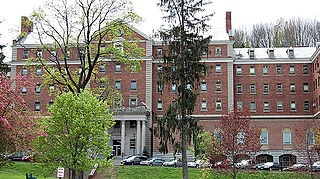
Bath VA Medical Center is a U.S. Veterans Administration hospital located in Bath, Steuben County, New York. Affiliated with the University of Rochester School of Medicine, it provides secondary care and operates clinics in Elmira and Wellsville, New York; and Coudersport and Wellsboro, Pennsylvania. It was added to the National Register of Historic Places in 2013, and designated a national historic district.

The Dayton Veterans Affairs Medical Center is located at 4100 West 3rd Street in Dayton, Ohio. Founded in 1867, it is one of the three oldest facilities of what is now the United States Department of Veterans Affairs. When founded, it was known as the Central Branch of the National Home for Disabled Volunteer Soldiers, and it is under this name that a portion of its campus, along with the adjacent Dayton National Cemetery, was designated a National Historic Landmark District in 2012, for its role in the history and management of veterans affairs.

Knoxville Veterans Administration Hospital Historic District is a nationally recognized historic district located in Knoxville, Iowa, United States. It was listed on the National Register of Historic Places in 2012. The first part of the property that was developed is a cemetery, which is located in the middle of the former VA golf course. It contains 40 plots. The State Industrial Home for the Blind was opened on the site of what would become the Veterans Administration Hospital on January 1, 1892. It remained in operation until April 30, 1900, when the last patient moved out. Two years later the facility was transformed into the State Hospital for Inebriates, which was a place of detention and treatment for males addicted to morphine, cocaine and other narcotics. Local citizens protested, and it was closed a few years later.
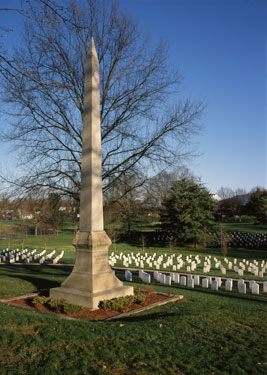
The Mountain Branch, National Home for Disabled Volunteer Soldiers was an old soldiers' home opened in 1904 in Mountain Home, Johnson City, Tennessee. Its site has since been taken over by the United States Department of Veterans Affairs, and is home to the Mountain Home National Cemetery and the James H. Quillen VA Center. Also known as the Mountain Home, its campus was designated a National Historic Landmark District in 2011, as a well-preserved example of an early 20th-century veterans care facility.






















